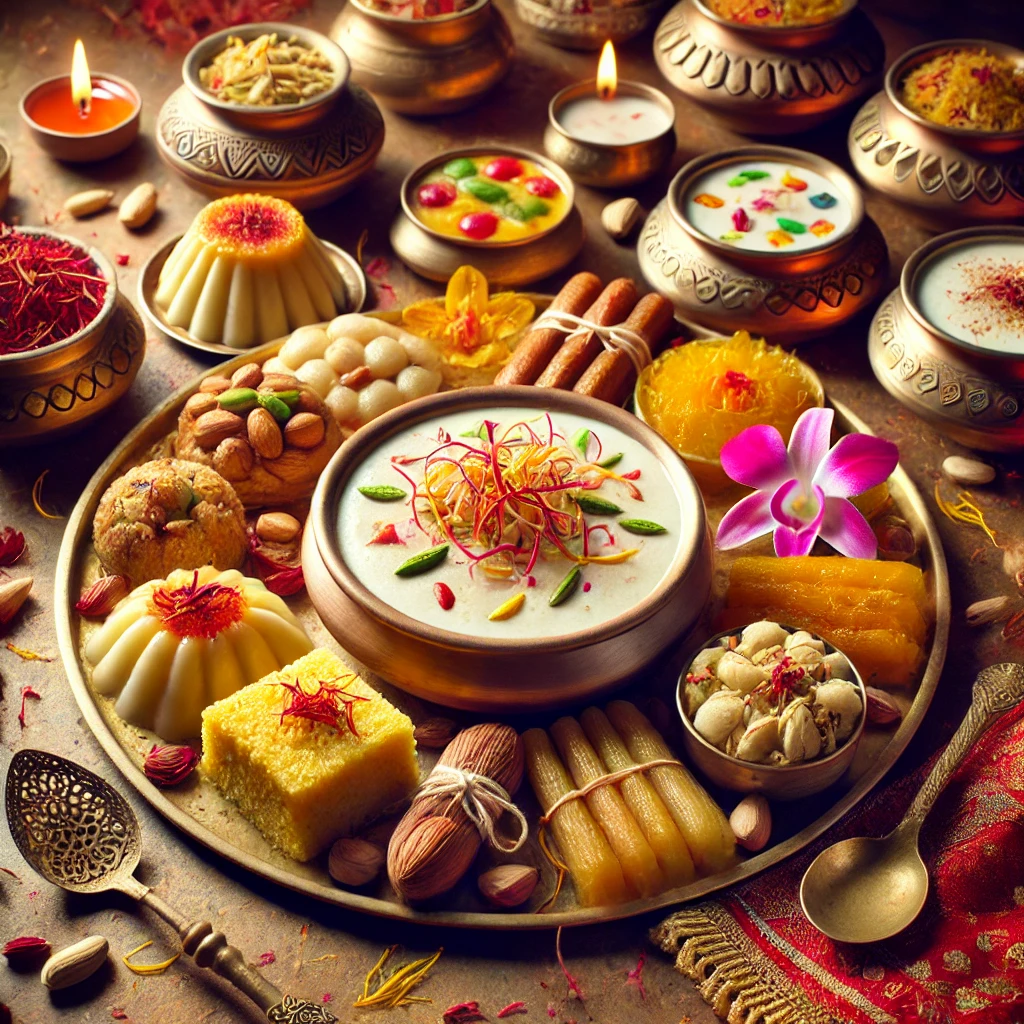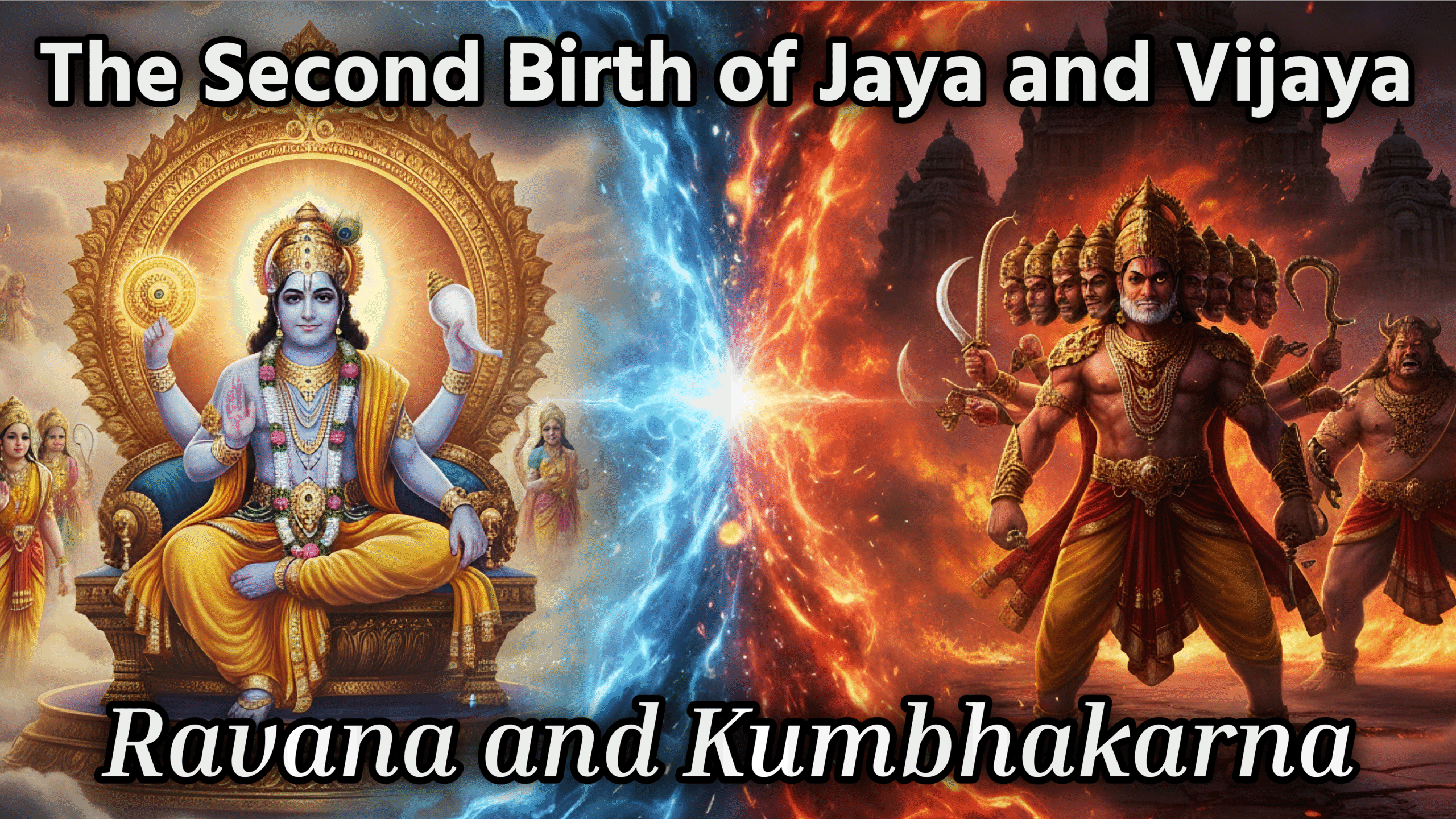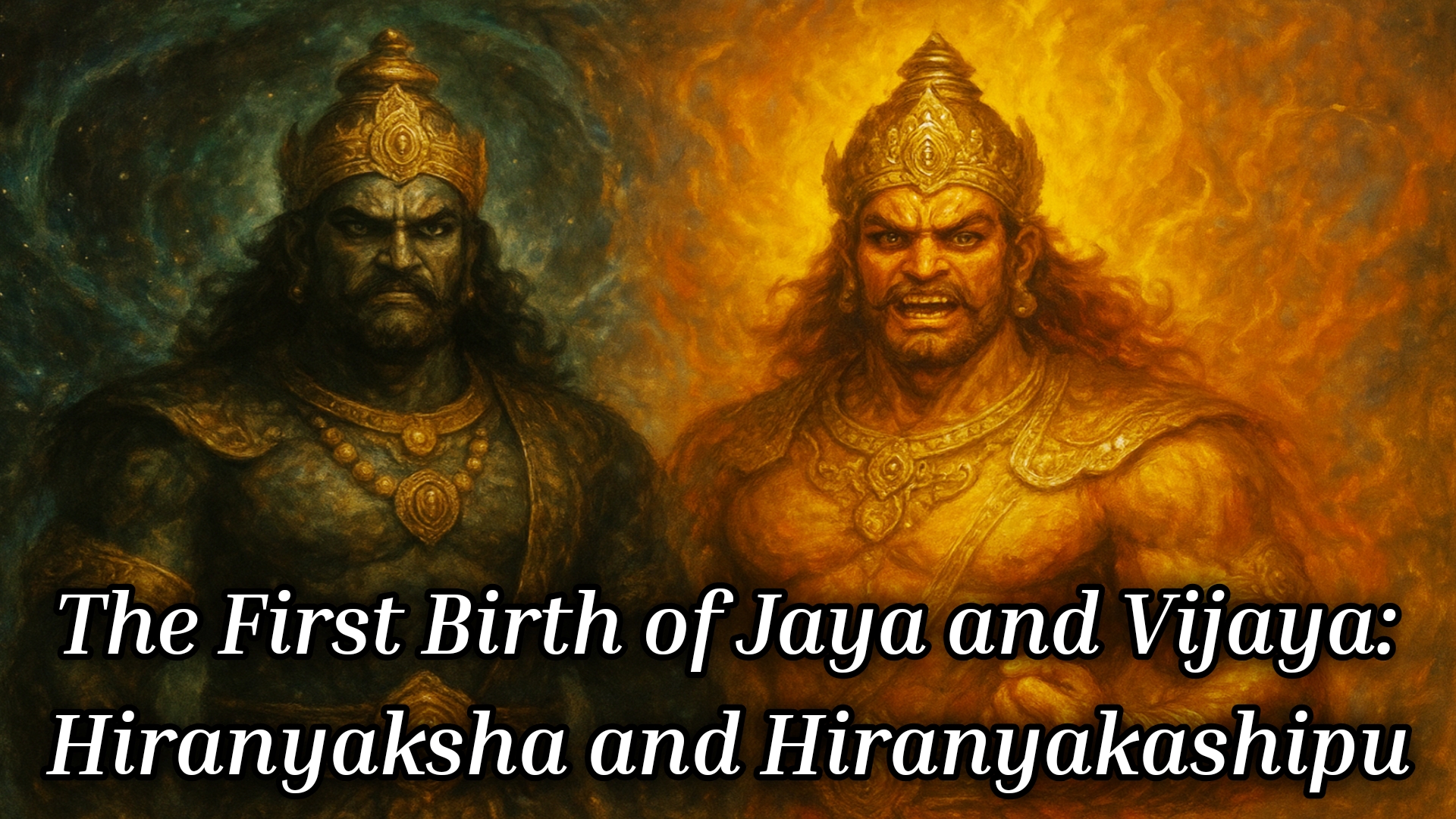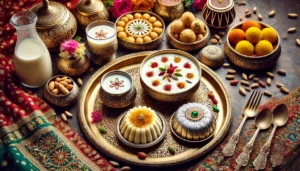
Divine milk-based dishes of India
Ksheer (Milk) Based Delicacies in Indian Tradition
Milk, or “Ksheer,” holds a unique and revered place in Indian culture, celebrated as both a vital dietary component and a sacred substance in rituals. Its versatility has given rise to numerous delicacies that are enjoyed across the country, transcending regional boundaries. These milk-based dishes are not only delectable but also steeped in spiritual and cultural significance, playing a central role in religious offerings, festive celebrations, and daily life. Among these, Kheer, Rasmalai, and Basundi stand out as quintessential desserts, embodying the richness of Indian culinary traditions.
The Spiritual Significance of Milk in Indian Culture
Milk has been venerated in India since ancient times. In Vedic literature, it is described as a divine substance bestowed by Kamadhenu, the sacred wish-fulfilling cow. Milk represents purity, nourishment, and abundance and is considered a “sattvic” food in Ayurveda, promoting spiritual clarity and mental harmony. This sacred status elevates milk and its derivatives to a central role in religious practices and culinary traditions.
From the consecration of deities with milk (abhishek) to its use in prasadam (sacred offerings distributed to devotees), milk symbolizes the essence of life and divinity. Its inclusion in sweets like Kheer, Rasmalai, and Basundi enhances their spiritual value, making them indispensable during rituals, festivals, and celebrations.
Table of Contents
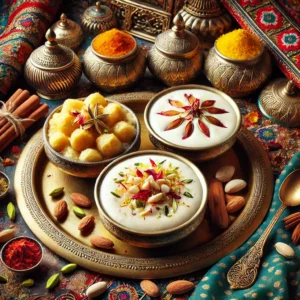
Divine milk-based dishes of India
Kheer: The Sweet Elixir of Divinity
Kheer, one of the oldest desserts in India, traces its origins back to ancient temples and royal kitchens. This rice pudding is prepared with minimal ingredients—milk, rice, and sugar—but its simplicity belies its depth of flavor and cultural importance. The offering of Kheer to deities is believed to invoke blessings and fulfill prayers. It is also distributed as prasadam in temples, particularly during festivals like Janmashtami (Lord Krishna’s birth) and Navratri.
Ingredients:
– 1 liter full-fat milk
– 1/4 cup rice (washed and soaked)
– 1/2 cup sugar
– 1/4 cup chopped dry fruits (almonds, cashews, raisins)
– 1/4 tsp cardamom powder
– A few strands of saffron (optional)
Preparation:
1. Boil the milk in a thick-bottomed pan and simmer it until it reduces slightly.
2. Add soaked rice and cook on low heat until the rice softens and the milk thickens.
3. Stir in sugar and cardamom powder, cooking for another 5-7 minutes.
4. Garnish with dry fruits and saffron. Serve warm or chilled.
Cultural Variations: In South India, a similar dish called “Payasam” is prepared using jaggery and coconut milk instead of sugar and cow’s milk. In Bengal, “Chaler Payesh” is made with fragrant gobindobhog rice, giving the dish a distinctive aroma.
Rasmalai: The Royal Dessert
Rasmalai, often referred to as “the king of Indian desserts,” is a luxurious creation that has graced royal banquets and modern celebrations alike. Made with soft cottage cheese (chenna) dumplings soaked in saffron-infused milk, Rasmalai is a testament to India’s culinary sophistication. It is commonly prepared during weddings, Diwali, and Eid, symbolizing prosperity and joy. In some traditions, Rasmalai is also offered to deities during special pujas.
Ingredients:
– 1 liter milk (for chenna)
– 1 tsp lemon juice
– 1 liter milk (for rabri)
– 1/4 cup sugar
– 1/4 tsp cardamom powder
– A pinch of saffron
– Chopped pistachios and almonds for garnish
Preparation:
1. Boil milk and curdle it with lemon juice to make chenna. Strain and press to remove excess water.
2. Knead the chenna into a soft dough and shape it into small discs.
3. Boil these discs in sugar syrup until they double in size.
4. Meanwhile, reduce another portion of milk to make rabri by simmering and adding sugar, cardamom, and saffron.
5. Soak the cooked chenna discs in the rabri. Garnish with nuts before serving.
Modern Innovations: Flavored variants of Rasmalai, such as mango or rose Rasmalai, have emerged, adding a contemporary twist to this traditional dish.
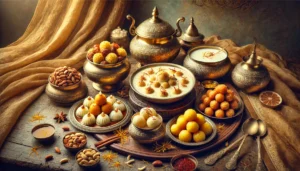
Divine milk-based dishes of India
Basundi: A Festive Delight
Basundi, a thickened milk dessert, is especially popular in Western India, including Maharashtra, Gujarat, and Karnataka. This rich and creamy dish is often prepared for festivals like Gudi Padwa, Makar Sankranti, and Navratri. Its luxurious texture and subtle flavors make it a favorite for both rituals and indulgent feasts.
Ingredients:
– 1 liter full-fat milk
– 1/3 cup sugar
– 1/4 tsp cardamom powder
– A few saffron strands
– Chopped nuts (almonds, pistachios)
Preparation:
1. Boil milk in a heavy-bottomed pan and simmer until it reduces to half its original quantity. Stir continuously to prevent burning.
2. Add sugar, cardamom powder, and saffron. Cook for 5-10 minutes.
3. Garnish with chopped nuts and serve warm or chilled.
Regional Influence: In Karnataka, Basundi is sometimes served with puris, adding a delightful contrast of textures.
Milk-Based Delicacies in Rituals and Festivals
1. Temple Offerings: Milk-based sweets like Kheer and Payasam are considered sacred and are offered during major Hindu festivals such as Janmashtami, Navratri, and Pongal. They are also used in Vishnu and Lakshmi pujas to symbolize purity and abundance.
2. Festive Celebrations: Desserts like Rasmalai and Basundi are prepared during auspicious occasions, from weddings to housewarming ceremonies, representing joy and prosperity.
3. Ayurvedic Relevance: Ayurveda emphasizes milk’s role in enhancing vitality and spiritual growth. Sattvic dishes like Kheer are often consumed during fasting periods to maintain energy and mental clarity.
Modern Relevance of Traditional Milk-Based Sweets
While these delicacies have deep roots in tradition, they continue to evolve to suit contemporary tastes and lifestyles. For example, health-conscious individuals are now experimenting with sugar-free Kheer or vegan alternatives using almond or coconut milk. Fusion desserts, such as Kheer parfaits or Rasmalai cheesecakes, showcase how these age-old recipes can adapt to modern culinary trends.
Conclusion
Milk-based dishes like Kheer, Rasmalai, and Basundi are much more than desserts—they are cultural artifacts that reflect the spiritual, festive, and culinary heritage of India. Whether served as a sacred offering or enjoyed as a festive indulgence, these delicacies carry the essence of Indian traditions. They remind us of the timeless connection between food, spirituality, and community, preserving the legacy of Ksheer in every spoonful.
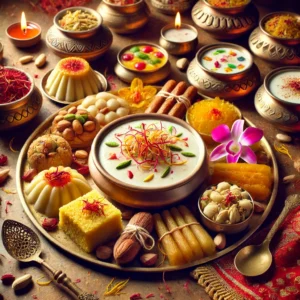
Divine milk-based dishes of India
FAQs on “Divine Flavors: Milk-Based Delicacies of India and Their Sacred Significance”:
1. What are some popular milk-based delicacies in Indian cuisine?
Some iconic milk-based delicacies include:
Kheer: A rice pudding made with milk, sugar, and dry fruits.
Rasmalai: Soft paneer discs soaked in saffron-flavored milk.
Basundi: Sweetened condensed milk with cardamom and nuts.
Shrikhand: A creamy dessert made from strained yogurt flavored with saffron and sugar.
Payasam: A South Indian variation of Kheer with regional ingredients like jaggery or coconut milk.
2. Why is milk considered sacred in Indian traditions?
Milk holds a significant place in Indian spiritual and cultural practices because:
It is linked to purity and sattvic qualities in Hindu philosophy.
It is a symbol of nourishment and abundance, often representing the divine sustenance provided by Kamadhenu, the wish-fulfilling cow in Hindu mythology.
Milk is integral to rituals, symbolizing spiritual cleansing and offering to deities.
3. How are milk-based dishes used in Indian rituals?
Milk-based dishes are integral to Indian rituals in the following ways:
Prasadam: Offerings like Kheer and Payasam are distributed to devotees after rituals.
Abhishekam: Milk is poured on idols during pujas and religious ceremonies, symbolizing purification.
Festivals: Milk-based sweets like Rasgulla and Basundi are prepared as offerings during celebrations like Janmashtami, Diwali, and Navratri.
4. What is the spiritual significance of Kheer in Indian culture?
Kheer, also known as Payasam in South India, is deeply tied to Indian spirituality:
It is a symbol of prosperity and sweetness, often offered to deities in temples.
It is a staple offering during Purnima (Full Moon) rituals, symbolizing completeness.
The creamy texture of Kheer represents the nectar of life, reinforcing spiritual fulfillment.
5. How does Basundi differ from other milk-based desserts?
Basundi is unique because:
It is made by slowly thickening milk over low heat, giving it a rich and creamy consistency.
It doesn’t include rice or grains like Kheer but is often flavored with cardamom, saffron, and nuts.
It is more concentrated compared to Payasam or Kheer, making it a rich dessert.
6. Are there regional variations of milk-based desserts in India?
Yes, milk-based desserts vary across India:
North India: Rasmalai, Kalakand, and Phirni are popular.
South India: Payasam and Mysore Pak with ghee are favorites.
East India: Rosogolla and Sandesh made with chhena (paneer).
West India: Shrikhand and Basundi are commonly prepared.
7. What ingredients enhance the flavor of milk-based dishes?
Key ingredients include:
Saffron: Adds a luxurious aroma and golden color.
Cardamom: Lends a fragrant, slightly spicy note.
Dry Fruits: Almonds, pistachios, and cashews add texture and richness.
Jaggery: Used as a natural sweetener, especially in Payasam.
Rose Water: Provides floral undertones in dishes like Rasmalai.
8. Are milk-based dishes healthy?
Milk-based desserts are nutritious as they:
Provide calcium and protein essential for bone health.
Contain healthy fats from milk and nuts.
Offer energy through natural sugars in milk and jaggery.
However, they should be consumed in moderation due to their sugar and calorie content.
9. Can traditional milk-based recipes be made vegan?
Yes, they can be made vegan by substituting dairy products:
Use almond milk, soy milk, or coconut milk instead of cow’s milk.
Replace ghee with coconut oil or vegan butter.
Opt for natural sweeteners like agave syrup or coconut sugar.
10. What festivals feature milk-based dishes prominently?
Milk-based dishes are central to many Indian festivals:
Janmashtami: Kheer and Makhan (butter) are offered to Lord Krishna.
Diwali: Rasmalai, Gulab Jamun, and Kalakand are festive favorites.
Navratri: Kheer and Payasam are offered during the nine-day worship.
Onam: Palada Payasam is an essential part of the Onam Sadhya feast.
11. What is Panchamrit, and how is it significant?
Panchamrit is a sacred mixture made of milk, yogurt, honey, ghee, and sugar:
It is used during pujas and abhishekam to bathe deities.
Symbolizes the five elements of nature and divine purity.
Consumed as prasadam for blessings and spiritual energy.
12. What makes Rasmalai a popular dessert?
Rasmalai is beloved for its:
Soft, spongy paneer texture.
Saffron-infused, creamy milk sauce.
Rich yet light flavor, perfect for celebrations.
13. Can these recipes be adapted for modern lifestyles?
Yes, these recipes can be adapted by:
Reducing sugar content or using jaggery.
Opting for low-fat or plant-based milk.
Using modern appliances like slow cookers or blenders to save time.
14. What role do milk-based dishes play in Indian hospitality?
Serving milk-based desserts is a gesture of warmth and respect for guests. They symbolize the host’s generosity and affection.
15. What are some lesser-known milk-based delicacies in India?
Some unique dishes include:
Kalakand: A grainy milk fudge popular in North India.
Rabri: A thickened, creamy milk dessert often paired with Jalebi.
Palada Payasam: A Kerala specialty made with rice flakes and milk.
16. What is the historical significance of milk-based dishes?
Milk-based dishes have roots in Vedic culture:
They are mentioned in ancient texts like the Rigveda as offerings to deities.
Milk was a central part of Indian agrarian society, making these dishes accessible and symbolic of prosperity.
17. How do rituals connect milk-based dishes to spirituality?
These dishes are believed to:
Purify the soul through their sattvic nature.
Represent divine nectar (Amrit) in religious contexts.
Enhance the spiritual vibrations of offerings through their purity and preparation.
18. What modern twists can be added to milk-based dishes?
Infuse international flavors like vanilla or cocoa.
Use molds or decorative plating for contemporary presentation.
Add superfoods like chia seeds or flax seeds for health benefits.
Summary
The article explores the rich tradition of milk-based delicacies in Indian culture, highlighting their deep-rooted connection to spirituality, rituals, and celebrations. It delves into the historical and religious importance of milk as a symbol of purity and abundance in Hinduism, often used in offerings and temple prasad. Iconic recipes like kheer, rasmalai, and basundi are discussed, showcasing their preparation methods and cultural significance. The article also reflects on how these delicacies transcend the kitchen to become an integral part of Indian festivals, ceremonies, and everyday life, embodying the timeless bond between food and faith.
Related Articles
- Restful Nights: Ayurvedic Remedies and Traditional Indian Practices to Overcome Insomnia and Late-Night Habits
- The Tridevi: Lakshmi, Saraswati, and Parvati – Their Roles and Powers
- “Divine Creatures of Ancient Indian Scriptures: Exploring the Role of Animals in the Vedas, Puranas, and Mahabharata”
- Nature and Spirituality: Exploring the Sacred Essence of the Himalayas, Ganga, and Other Natural Wonders”
- “Reviving the Gurukul System: Relevance and Lessons for Modern Education”
- “Exploring Greek and Indian Mythology: Similarities Between Greek and Indian Mythology “
- “Embracing Sattvic Living: Harmonizing Mind, Body, and Soul Through Food and Lifestyle”
- “Charity and Prosperity: Exploring the Concept of Daan and Its Financial Relevance in Modern Life”
- How to Build an Eco-Friendly Home Inspired by Vastu Shastra
- Comparison of Ancient and Modern Sports: How Traditional Sports Have Influenced Contemporary Games
- “Timeless Lessons from Ancient Tales: Linking Samudra Manthan and Ganga’s Descent to Modern Ecological Challenges”
- “Reviving Sanskrit: How AI is Preserving Ancient Languages for the Future”
- “Mathura: The Sacred Land of Lord Krishna’s Divine Leelas”
- Investing for Future Generations: Lessons from Indian Traditions on Legacy Building and Wealth Preservation
- “Ancient Indian Wisdom: Timeless Lessons for Tackling Today’s Climate Crisis”
- “Artificial Intelligence and Spirituality: Transforming Ancient Practices for the Modern World”
- “Gold and Real Estate in India: Timeless Assets Shaping Financial Strategies”
- “Divine Feminine Power in Hindu Mythology: The Legends of Durga, Saraswati, and Lakshmi”
- “Divine Beings of Sanatan Dharma: The Spiritual Significance of Sacred Animals in Hinduism”
- “Symbolism in Mythological Art: Unlocking Hidden Meanings in Ancient Temple Carvings”
- “Exploring Technological Advancements in Ancient India and Civilizations: Vimana, Metallurgy, & Water Management systems”
- Unveiling the Mysteries: Ancient Temples of Sanatan Dharma , Mysterious Temples of India
- “The Scientific Knowledge of Sanatan Dharma: Ancient Wisdom Meets Modern Science”
- Ancient Indian Sports and Games: Celebrating a Legacy of Skill, Strength & Strategy”
- “Exploring the Cosmic Link: The Connection Between Astronomy and Vedic Astrology”
- The Power of Sanskrit: Unlocking the Divine Language of the Gods
- “The End of Kaliyuga: A Sanatan Insight into the World’s Final Chapter”
- Explore more articles on Prachin Sanatan Yuga.
-
The Third Birth of Jaya and Vijaya: Shishupala and Dantavakra
The Third Birth of Jaya and Vijaya 🕉️ How the Fiercest Enemies of Krishna Returned as His Eternal Devotees The grand theatre of Sanatan Dharma holds stories where even conflict becomes a sacred bridge to salvation. Among the most unforgettable of these cosmic dramas is the tale of Jaya and Vijaya, the revered gatekeepers of…
-
The Second Birth of Jaya and Vijaya: Ravana and Kumbhakarna
The Second Birth of Jaya and Vijaya: Ravana and Kumbhakarna In the endless cycle of creation and dissolution, every soul — even the most divine — experiences the law of karma and destiny. Among the most profound stories in Sanatan Dharma is that of Jaya and Vijaya, the revered gatekeepers of Vaikuntha, whose devotion to…
-
The First Birth of Jaya and Vijaya: Hiranyaksha and Hiranyakashipu
The First Birth of Jaya and Vijaya: Hiranyaksha and Hiranyakashipu In Hindu mythology, Jaya and Vijaya are the revered gatekeepers of Vaikuntha, the celestial abode of Lord Vishnu. Known for their unwavering devotion and courage, these divine guardians are more than just protectors—they play an essential role in maintaining the cosmic order. However, a fateful…
Divine milk-based dishes of India Divine milk-based dishes of India Divine milk-based dishes of India Divine milk-based dishes of India Divine milk-based dishes of India Divine milk-based dishes of India Divine milk-based dishes of India Divine milk-based dishes of India
Divine milk-based dishes of India Divine milk-based dishes of India Divine milk-based dishes of India Divine milk-based dishes of India Divine milk-based dishes of India Divine milk-based dishes of India Divine milk-based dishes of India Divine milk-based dishes of India
Divine milk-based dishes of India Divine milk-based dishes of India Divine milk-based dishes of India Divine milk-based dishes of India Divine milk-based dishes of India Divine milk-based dishes of India Divine milk-based dishes of India Divine milk-based dishes of India
